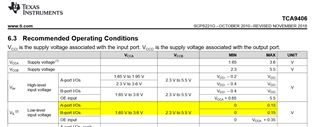- Ask a related questionWhat is a related question?A related question is a question created from another question. When the related question is created, it will be automatically linked to the original question.
This thread has been locked.
If you have a related question, please click the "Ask a related question" button in the top right corner. The newly created question will be automatically linked to this question.
The TCA9406 is defined in the specification with an input low level of 0.15V.
How should the I²C bus work with such a low input level value when other I²C-devices define their output low level voltage with e.g. 0.4V?
The TCA9406 is an analog switch and does not have switching thresholds. This value is specified only to allow you determine the voltage drop (VOL − VIL) over the switch. In an I²C bus with two devices A and B, you would have the restriction VOL(A) ≤ VIL(B). The TCA9406 then adds an offset, and you have the restriction VOL(A) + (VOL(TCA) − VIL(TCA)) ≤ VIL(B).
See [FAQ] Why are the TXS01xx VIH/VIL specifications so stringent?
As Clemen's pointed out, the device doesn't technically require the voltage to be 0.15V to pass a low signal.
As you pointed out, I2C devices have a 0.4V output (this is a spec from I2C standard which sets the current at 3mA max to achieve a max output of 0.4V which also means the max Ron an I2C output driver should be is 133 ohms though it should be less). This 0.15V recommended spec tries to target an output voltage of 0.4V on the opposite side. Since this is a analog switch like Clemen's stated, the output voltage on the otherside will be what the input voltage is plus Ron of the device times the current through the device so the output voltage will always be larger. The datasheet tries to target 0.4V given 1mA through the device (VoLA/B spec in the datasheet).
-Bobby